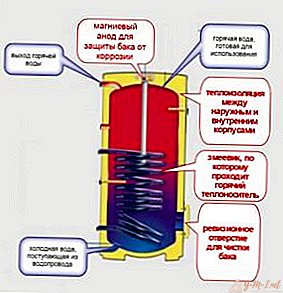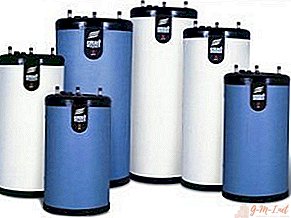 The need for hot water in any home or office is undeniable - for this, boilers are installed. Such devices are electric, where a heater is present as a heater. There are also gas plants with a burner on the market. In addition to the above, indirect types of aggregates are produced.
The need for hot water in any home or office is undeniable - for this, boilers are installed. Such devices are electric, where a heater is present as a heater. There are also gas plants with a burner on the market. In addition to the above, indirect types of aggregates are produced.
Indirect water heater what is it
A design feature of indirect type boilers is the lack of their own heating element. Such a device works by generating heat from the outside, usually from a central heating system or solar panels. It is possible to use a cascade system, that is, the heating process in an indirect type unit occurs after the activation of the main boiler.
REFERENCE! The need for application arises when it is necessary to increase the supply of hot water due to low pressure, in the house due to heating cold or to establish an additional point.
The device and principle of operation of the indirect heating boiler
The so-called indirect heating water heater is a cylindrical tank. The device consists of the following elements:
- housing;

- thermal insulation;
- stainless steel tank;
- temperature meter;
- heat exchange systems;
- anode of magnesium.
The installed insulation between the tank and the body provides the least heat loss. A heat exchanger is located inside the tank. It is made of a steel or brass tube, which is laid on the bottom with special bends, thereby ensuring uniform heating of the water. An installed thermometer monitors the temperature. To protect against corrosion, a magnesium anode is installed.
REFERENCE! Considering the peculiarities of seasonal operation and consumer demands, modern indirect-type water heaters are more often made combined, combined with gas or electric heating.
The water heater can be installed:
- On the wall, when there is not enough space in the room or you want to save it. But it must be taken into account that the fastenings are carried out by brackets having weight restrictions, therefore the mass of the boiler should not exceed 100 kg.
- On the floor, used for devices from 100 kg, on special stands.
Features of installation and connection of a water heater
Before you turn on, you must properly install the device. It is necessary to consider the following nuances:
- First you need to choose the installation location. This is usually a bathroom or toilet.
- When installing, it is important to consider: ease of dismantling, the ability to get to the connections. This will be necessary during maintenance and repair work. Do not interfere with the passage and block other engineering systems.

- If in the room where the water heater is installed, the walls are not capital, but plasterboard, then you can not fix it. In this case, the floor version is used or the installation is carried out on a metal stand.
- Connection to the water supply and electricity system is carried out by qualified specialists. Particular attention should be paid to the fact that before connecting to the electric network, the metal case must be grounded.
- After installation, it is included in the electrical network, according to the instructions specified in the product passport. Checks the correct operation of the device.
- After supplying hot water to the heat exchanger of the water heater, the heat carrier must constantly circulate to maintain the temperature - for this a pump is installed. After heating to the desired temperature, the pump turns off. Water can remain hot for a long time due to thermal insulation.
IMPORTANT! The stainless steel tank sooner or later undergoes destruction under the influence of water. It is necessary to pay attention to the condition of the tank seams - often they are the first to leak.
Advantages and disadvantages of an indirect heating boiler
Note the advantages of an indirect type water heater:
- The ability to heat large volumes. The wall-mounted device can heat up to 150 liters, the floor-mounted one - up to 300 liters.
- Saving. In the midst of the heating season, significant savings in utility costs are obtained.
- The ability to organize multiple hot water distribution points. This is true for a large private home or office.
REFERENCE! The use of the combined version is currently in great demand, since seasonal shutdown and a decrease in the pressure of hot water are increasingly happening in congested microdistricts of megacities. A combined type water heater comes to the rescue, which works from the heating medium in the winter, and in the warm period comes from electricity or gas.
Disadvantages:
- High cost compared to peers. As a rule, the high cost of the product is determined by the prices of spare parts and consumables.
- Water heats up for a long time, due to the large volume of the tank and heating technology. If used for frequent use in everyday life, then a smaller volume can be provided.
- Heating depends on the heating medium. The heating period as an indirect option is justified at the height of the heating season. In the warm days of winter, when the temperature of the coolant drops, the use of an indirect device becomes impossible - heating of the water does not occur.
- The temperature ceiling of heating is lower than that of electric and gas water heaters. This characteristic limits the use of water heaters of this type in health and children's institutions, where there are strict requirements for the temperature of hot water.
Choosing an indirect boiler
When choosing a water heater, you need to pay attention to the following parameters:
- What volume. It is necessary to decide for what purpose it is being bought, what is the possible expense, and will there be additional points. Do not forget that a large volume will warm up for a long time.

- What material is the coil made of - steel or brass. They are removable and welded to the tank. As a rule, removable brass - they are preferable.
- What material is the tank made of? Inexpensive models are often made not of stainless steel. They have a spray, which subsequently becomes cracked, which leads to rapid wear.
- What material is used for insulation. It should be made of polyurethane, not foam. Foam rubber has poor thermal insulation characteristics, so it will not allow the device to fully work.
A water heater is a necessary and useful household appliance. A huge number of models are offered on the market - in terms of cost and principle of operation. From budget to premium. So, you can make a choice without overpaying too much. It remains only to choose a device whose characteristics are satisfactory.




Leave Your Comment